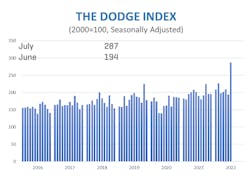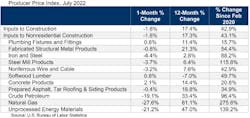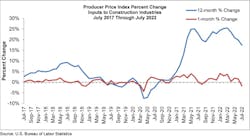Defying Recession, Construction Activity Gains Again
If the pandemic has taught us anything over the last 30 months, it is to expect the unexpected. And that appears to be holding true for the U.S. economy now, which technically fell into recession this summer, after recording two consecutive quarters of loss in the Gross Domestic Product (GDP).
But in this new era of historic curveballs, that traditional definition of recession may no longer apply, as other economic indicators on inflation and employment have simultaneously improved. At the same time, global supply chain issues have eased somewhat and massive federal funding of long-delayed infrastructure projects is moving forward. Add to that the Aug. 16 signing of the unexpected Inflation Reduction Act (IRA), which should significantly boost clean energy development nationally, and the economic doomsayers have surprisingly scant evidence to point to.
Remarkably, total U.S. construction starts rose 48% in July to a seasonally adjusted annual rate of $1.36 trillion, according to Dodge Construction Network (DCN). This gain results from the start of three multi-billion-dollar manufacturing plants and two LNG export facilities. However, even without these projects, total construction starts would still have increased 7%. Nonresidential building starts rose 79% in July, and nonbuilding starts jumped 120%, even as residential starts decreased 8%.
“Mega-projects aside, construction continues to improve despite the pressure created by higher interest rates and labor scarcity,” said DCN Chief Economist Richard Branch. “Combined with the strong labor market, this is another indicator that the U.S. is not currently in a recession. However, the Federal Reserve will continue to aggressively raise interest rates until they feel that inflation is under control. This will create mounting pressure on building activity and potentially lead to a slowdown in construction starts by year-end.”
Year-to-date, total construction was 11% higher in the first seven months of 2022 compared to the same period of 2021. Nonresidential building starts rose 22% over the year, residential starts were 1% higher, and nonbuilding starts were up 16%.
For the 12 months ending July 2022, total construction starts were 10% above the 12 months ending July 2021. Nonresidential starts were 21% higher, residential starts gained 4%, and nonbuilding starts were up 10%.
- The largest nonresidential building projects to break ground in July were the $10-billion Intel Semiconductor plant in Jersey Township, OH, the $2.9-billion BlueOval SK Battery Park Ford plant in Glendale, KY, and the $2.8-billion BlueOval City manufacturing campus in Stanton, TN. (Source: Dodge Construction Network)
"New project work coming into architecture firms, as well as inquiries for future projects, have been very strong, indicating design revenue at architecture firms will continue to grow," said Kermit Baker, PhD, chief economist for the American Institute of Architects (AIA). Delivering the group's midyear Consensus Forecast on July 18, he added, "Growing workloads have pushed up backlogs at architecture firms, now averaging seven months and near their highest level since before the Great Recession (of 2008-09.)"
Inflation Appears To Have Peaked
Meanwhile, on the inflation front, the price of materials and services used in nonresidential construction fell 1.3% last month, according to the latest Producer Price Index (PPI) data, released Aug. 11 by the U.S. Bureau of Labor Statistics (BLS). Still, those prices remained 14.6% above their July 2021 level. And there was not an across-the-board decline in prices, as the index for new nonresidential building construction—a measure of what contractors calculate they would charge to erect five types of nonresidential buildings—continued to climb, increasing 5.4% from June to July and 23.9% over 12 months, according to an analysis of the data by the Associated General Contractors of America (AGC).
“Contractors welcome any relief they can get in the cost of most construction materials,” said AGC CEO Stephen E. Sandherr. “But it is still too hard to acquire most materials and prices remain quite elevated for many key products.”
Even so, construction input prices for July were down in eight of 11 subcategories on a monthly basis. Prices in all three energy subcategories fell, with natural gas prices dropping 27.6%, the largest decrease. Unprocessed energy materials prices were down 21.2%, while crude petroleum prices fell 19.1%.
“Today’s PPI data supplies additional evidence that inflation has peaked,” said ABC Chief Economist Anirban Basu. “A weakening global economy and ongoing supply chain adjustments have resulted in significant declines in the prices of a number of key commodities, ranging from oil to steel. While the risk of recession remains elevated, recent government reports on consumer and producer prices make it more likely that the Federal Reserve will be able to engineer a soft landing or that any recession to come could be quite mild. For contractors who have seen their profit margins diminished by elevated materials prices, a trend confirmed by ABC’s Construction Confidence Index, this is a welcome development.”
Indeed, despite the recent slight declines in GDP, the overall economic mood seems to have shifted, from growing dread to renewed hope.
“For the last two years, the global construction industry has been at the mercy of disrupted and broken supply chains that have made critical material scarce and have caused some significant increases in the cost of building,” said Patrick Ryan, Executive Vice President for the Americas at Linesight, a Dublin-based international construction consulting firm. “The good news is that many of these materials are now more readily available, which is causing material prices to stabilize. But we are not out of the woods yet because of high energy costs, labor shortages, and tariffs that are tempering the availability of materials and keeping the cost of construction from coming down.”
Toward that end, many economists point to the new $500-billion Inflation Reduction Act as important legislation that will help both the economy and the planet over the next decade, yielding broader benefits far beyond prices.
"This is a very big deal," wrote Nobel Prize-winning economist Paul Krugman last week. "The act isn’t, by itself, enough to avert climate disaster. But it is a huge step in the right direction and sets the stage for more action in the years ahead. It will catalyze progress in green technology; its economic benefits will make passing additional legislation easier; (and) it gives the United States the credibility it needs to lead a global effort to limit greenhouse gas emissions."
Overly optimistic, perhaps, but such sentiment, itself, is a welcome change after such a prolonged period of doom and gloom.
###########
About the Author
Rob McManamy
Editor in Chief
An industry reporter and editor since 1987, McManamy joined HPAC Engineering in September 2017, after three years with BuiltWorlds.com, a Chicago-based media startup focused on tech innovation in the built environment. He has been covering design and construction issues for more than 30 years, having started at Engineering News-Record (ENR) in New York, before becoming its Midwest Bureau Chief in 1990. In 1998, McManamy was named Editor-in-Chief of Design-Build magazine, where he served for four years. He subsequently worked as an editor and freelance writer for Building Design + Construction and Public Works magazines.
A native of Bronx, NY, he is a graduate of both the University of Virginia, and The John Marshall Law School in Chicago.
Contact him at [email protected].



